|
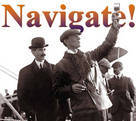
 Up
Up

 Help That
Help That
Man Fly

(You are here.)
 Down
Down




  Need
to Need
to
find your
bearings?
Try
these
navigation aids:
If
this is your first
visit, please stop by:
Something
to share?
Please:



|
|
Available in Française, Español, Português,
Deutsch, Россию, 中文,
日本, and others.
 omewhere
south of Muskogee, Oklahoma, the clock ran out on the Hearst Prize.
Cal had spent the 30 allotted days crossing the continent, and he
was still over a thousand miles from the western shore. As the days
ticked down, the crowds that greeted him had grown thinner and his
crew more despondent. All expected him to concede. Cal, however,
would not hear of it. "This is no longer a race against time," he
told the reporters and crew aboard the Vin Fiz Special on 17
October 1911. "It is not against a competitor. This is a
demonstration that man is not held down by the dead hand of the
past." omewhere
south of Muskogee, Oklahoma, the clock ran out on the Hearst Prize.
Cal had spent the 30 allotted days crossing the continent, and he
was still over a thousand miles from the western shore. As the days
ticked down, the crowds that greeted him had grown thinner and his
crew more despondent. All expected him to concede. Cal, however,
would not hear of it. "This is no longer a race against time," he
told the reporters and crew aboard the Vin Fiz Special on 17
October 1911. "It is not against a competitor. This is a
demonstration that man is not held down by the dead hand of the
past."
Jasper Allen, one of the mechanics in the Vin Fiz crew,
recalled, "Somehow, when the prize was gone, a second wind blew up. The
crowds grew bigger and the cheers louder." Chalked messages to those
aboard the train began to appear on water towers along the railroad,
"Help that man Rodgers fly across America." The Vin Fiz flew on
propelled not just by the tenacity of Cal Rodgers, but by the well
wishes of a nation.
On 5 November 1911, 49 days from the start of his journey, Cal
Rodgers and the Vin Fiz reached Pasadena, California, just 27
miles from the Pacific Ocean. As his wheels touched the ground in
Tournament Park, the assembled citizens of Pasadena rushed him
screaming, crying, and trying to touch him. It took Cal twenty minutes
to negotiate a few dozen yards through the excited throng to the judges'
platform, where officials draped an American flag around his shoulders.
He was hoisted into a car and driven round and round the track while
people cheered, danced, applauded, and wept with emotion. A reporter
from the Examiner jumped on the running board and shouted, "What
about the prize? What about the Hearst money?"
"Forget the prize," Cal shouted back. "I did it, didn't I? I did it!
Well, almost. He still had 27 miles to fly. Cal rested for a few days
while the Vin Fiz was completely overhauled and spruced up with a
fresh set of wing coverings. He took off from Pasadena on 12 November
while crowds assembled at Long Beach to witness the end of his journey.
But just 12 miles short of his goal, the engine sputtered and quit,
forcing him to land. He was back in the air after a quick repair, but
the engine continued to give him fits. He lost altitude, banked hard to
avoid a power line, and plowed into the ground. Once again, he wrecked
the Vin Fiz and for the first time, he was injured in the
process. He was diagnosed with one ankle broken, the other sprained,
broken ribs, twisted back, severe burns, and a concussion. The flying
machine was almost a total loss — but the bottle of Vin Fiz was whole
and entire.
|
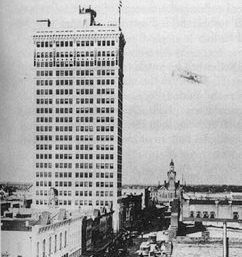
The Vin Fiz rounds a skyscraper in Waco, Texas.
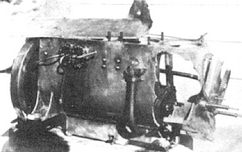
Over Imperial Junction, California, the engine exploded, tearing
itself apart. Cal's totem bottle of Vin Fiz, just inches away, was
unscathed.
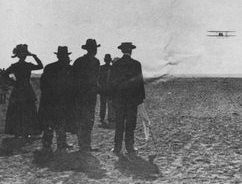
Take-off from Marfa, Texas.
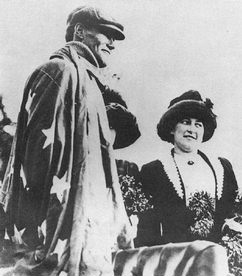
Cal Rodgers with an American flag draped around his
shoulders after his triumphant landing in Pasadena. The Rose Queen is to
his right.
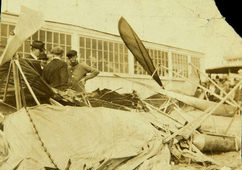
The crash in Compton all but destroyed the
Vin Fiz and severely injured
Rodgers. The aircraft was completely rebuilt while he convalesced.
|
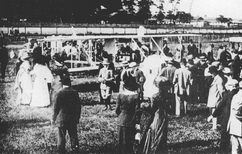
The
Vin Fiz lands in Dallas, Texas -- the Hearst Prize was lost
but the grandstands were full.
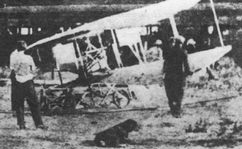
Once again, Cal Rodgers wrecked the
Vin Fiz on take-off from Spofford, Texas. Take-offs seemed to be
the most dangerous time in this aircraft.
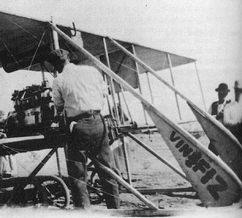
Cal installs a new engine in his aircraft.
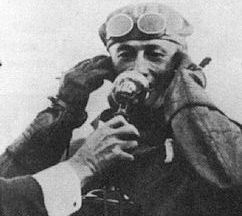
Cal calls the Associated Press wire service moments after landing in
Pasadena.
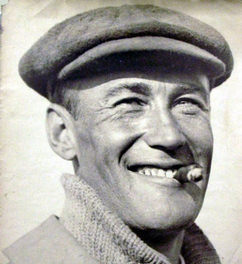
Cal was all smiles in Pasadena. The quest was all but accomplished -- or
so he thought.
|